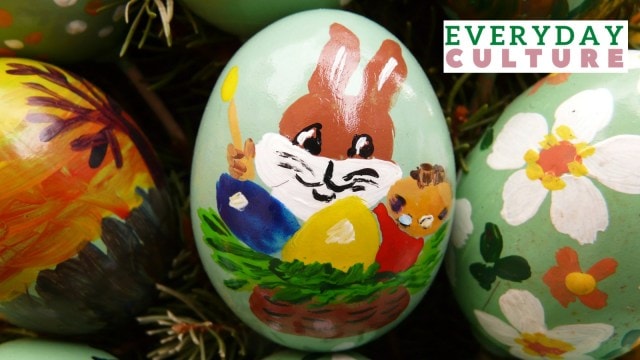- India
- International
Why are decorative eggs, chocolate and rabbits associated with Easter celebrations?
Some common icons associated with Easter go back to Pagan religions and come from trade and immigration, while others are linked to fertility and the advent of Spring.
 Rabbits are associated with Easter iconography – painted on eggs, seen as the bearer of eggs, and more. (Via Wikimedia Commons).
Rabbits are associated with Easter iconography – painted on eggs, seen as the bearer of eggs, and more. (Via Wikimedia Commons).Easter Sunday is a day of festivities. After Christians observe the sombre occasion of Good Friday, which marks the day Jesus Christ is believed to have been crucified, Easter celebrates his resurrection.
Across the world, diverse traditions are observed on this day. Special services are held at churches, hymns are sung, parades are organised and feasts are prepared. In modern times, Easter has also become anonymous with chocolatey or decorated Easter eggs and the Easter bunny. How did this happen?
Did Easter always mean eggs and rabbits?
Traditionally, items such as hot cross buns, which are sweet and fruity loaves of bread baked to feature the shape of a cross, and lamb-based dishes were eaten around this time of the year.
 Hot cross buns made with figs and pecan. (Via Wikimedia Commons)
Hot cross buns made with figs and pecan. (Via Wikimedia Commons)
The egg supposedly became a part of Easter in and around the 13th century. It is believed that its use was borrowed from several Pagan traditions, meaning religions which preceded the major faiths we know today.
Eggs were seen positively, as a symbol of fertility and birth, and they befitted a festival commemorating the resurrection of Christ.

Why are eggs decorated on Easter?
According to Encylopedia Britannica, “Because the Christian church did not allow meat or animal-derived products, like eggs, to be eaten during Holy Week, the eggs laid by chickens during this period were instead decorated to identify them as Holy Week eggs that could not be consumed.”
Holy Week begins on the Sunday before Easter, called Palm Sunday. It marks Jesus reaching Jerusalem, where his followers greeted him with palm leaves. Different religious significance days are observed over the week leading up to Easter.
Easter is also preceded by a 40-day period known as Lent, in which Christians often pray and fast. They may give up something dear to them, or a bad habit. It is linked to the belief that Jesus spent 40 days after his resurrection fasting in the desert and enduring temptation by Satan. At the end of it, he is said to have ascended to heaven.
Additionally, the date for celebrating Easter is fixed based on the full Moon. In general, it is observed in either March or April, leading to its association with the onset of Spring – a season symbolising growth and rebirth in nature.
An article in The Conversation notes: “It’s not known exactly when people started to decorate their eggs, but research has pointed to the 13th century, when King Edward I gave his courtiers eggs wrapped in gold leaf.”
Natural dyes such as beetroot were used to decorate the eggs. In England, flower petals were also part of the decoration.
And where do chocolate eggs on Easter come from?
Chocolate was unknown to Europe until the 17th century, when it was brought from Central and South America. The Conversation says: “In 1669, the Earl of Sandwich paid £227 – the equivalent of around £32,000 today – for a chocolate recipe from King Charles II.”
Initially, chocolate was known as a drink, consumed with some spices. It remained inaccessible and expensive for long, but by the 20th century, supermarkets helped bring it to the people at low prices in the UK.
Britannica says that another Easter fixture, of kids hunting for hidden Easter eggs, dates back to around the 16th century. “Martin Luther, a Protestant reformer, organized the activity where men would hide eggs for women and children to find.”
It was meant to serve as a “loose reenactment of the Resurrection” when women found Christ’s tomb empty after his crucifixion. To symbolise this, some hollowed-out shells are also placed along with the real prizes – the chocolate eggs.
Finally, what about the Easter Bunny’s origins?
Rabbits are associated with Easter iconography – painted on eggs, seen as the bearer of eggs, and more. Its origins are supposed to be in Germany, says one theory.
Google’s Arts and Culture platform says: “The story goes that the Easter Bunny would lay brightly colored eggs for well-behaved children to find on the morning of Easter Sunday. Some children would prepare nests in the garden for eggs to be left in, and even leave out carrots to refuel the Bunny after all its hopping.”
It adds: “The idea soon spread from Germany, finding its way to the US when an influx of German immigrants arrived in Pennsylvania in the early 18th century. In England, it was Queen Victoria who helped popularize the tradition after participating in egg hunts as a young girl in the gardens of Kensington Palace, put on by her German-born mother, the Duchess of Kent.”
Rabbits are also known for giving birth to a big litter, again harking back to the festival’s links with fertility and Spring.
More Explained
EXPRESS OPINION
Apr 04: Latest News
- 01
- 02
- 03
- 04
- 05































